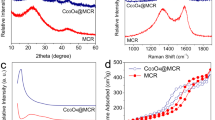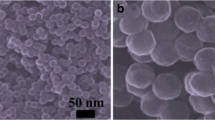Abstract
Metal organic frameworks (MOF)-808@sulfur composite electrode materials were prepared by hydrothermal reaction with using organic ligands and metal ions. We tried to find the optimum particle size to obtain the enhanced electrochemical performance to be used as an electrode for lithium sulfur batteries. Various particle sizes (20 nm ~ 700 nm) and shapes were successfully prepared by different amounts of modulator and solvent for preparation of MOF-808. Four kinds of substances were analyzed for composition and electrochemical analysis. Electrochemical characterizations were also conducted by cyclic voltammetry and galvanostatic charge–discharge tests. As a result, MOF-808@S(20), with a particle size of about 180 nm, exhibited the best redox reaction, providing the highest initial specific capacity of 999.4 mAh g−1 at 100 mA g−1. Based on this study, we explain the possibility of commercialization of MOF-808 composite as an electrode material of lithium sulfur batteries, which has advantages of stable host electrode structure and facile particle size control.








Similar content being viewed by others
Availability of Data and Material (data transparency)
Available.
References
M.-H. Chung, J. Kim, The internet information and technology research directions based on the fourth industrial revolution. KSII Trans. Internet Inf. Syst. 10(3), 1311–1320 (2016)
S. Wu, R. Ge, M. Lu, R. Xu, Z. Zhang, Graphene-based nano-materials for lithium–sulfur battery and sodium-ion battery. Nano Energy. 15, 379–405 (2015)
N. Deng, W. Kang, Y. Liu, J. Ju, D. Wu, L. Li, B.S. Hassan, B. Cheng, A review on separators for lithiumsulfur battery: progress and prospects. J. Power Sources 331, 132–155 (2016)
H.-Y. Lee, Y. Jung, S. Kim, Conducting polymer coated graphene oxide electrode for rechargeable lithium-sulfur batteries. J. Nanosci. Nanotechnol. 16(3), 2692–2695 (2016)
Q. Pang, L.F. Nazar, Long-life and high-areal-capacity Li–S batteries enabled by a light-weight polar host with intrinsic polysulfide adsorption. ACS Nano 10(4), 4111–4118 (2016)
H. Wang, Y. Yang, Y. Liang, J.T. Robinson, Y. Li, A. Jackson, Y. Cui, H. Dai, Graphene-wrapped sulfur particles as a rechargeable lithium–sulfur battery cathode material with high capacity and cycling stability. Nano Lett. 11(7), 2644–2647 (2011)
H. Li, M. Eddaoudi, M. O’Keeffe, O.M. Yaghi, Design and synthesis of an exceptionally stable and highly porous metal-organic framework. Nature 402(6759), 276–279 (1999)
L. Feng, K.-Y. Wang, J. Powell, H.-C. Zhou, Controllable synthesis of metal-organic frameworks and their hierarchical assemblies. Matter 1(4), 801–824 (2019)
S. Yuan, L. Feng, K. Wang, J. Pang, M. Bosch, C. Lollar, Y. Sun, J. Qin, X. Yang, P. Zhang, Stable metal–organic frameworks: design, synthesis, and applications. Adv. Mater. 30(37), 1704303 (2018)
A.E. Baumann, X. Han, M.M. Butala, V.S. Thoi, Lithium thiophosphate functionalized zirconium MOFs for Li–S batteries with enhanced rate capabilities. J. Am. Chem. Soc. 141(44), 17891–17899 (2019)
G. Cai, H.L. Jiang, A modulator-induced defect-formation strategy to hierarchically porous metal-organic frameworks with high stability. Angew. Chem. Int. Ed. 56(2), 563–567 (2017)
J. Xu, J. Liu, Z. Li, X. Wang, Y. Xu, S. Chen, Z. Wang, Optimized synthesis of Zr (IV) metal organic frameworks (MOFs-808) for efficient hydrogen storage. New J. Chem. 43(10), 4092–4099 (2019)
J.-H. Hong, S.-J. Park, S. Kim, Synthesis and electrochemical characterization of nanostructured Ni-Co-MOF/graphene oxide composites as capacitor electrodes. Electrochim. Acta 311, 62–71 (2019)
H.-Y. Lee, K.-Y. Kim, S. Kim, Electrochemical characterization of nano-structured graphene oxide/CNT electrodes containing sulfur for lithium rechargeable cells. J. Nanosci. Nanotechnol. 16(9), 9186–9189 (2016)
W.-S. Song, Y. Jung, S. Kim, Electrochemical study of bimetal organic frameworks with graphene oxide for lithium-sulfur cells as nanoarchitectonics. J. Nanosci. Nanotechnol. 20(5), 2746–2749 (2020)
J.Y. Hong, Y. Jung, D.-W. Park, S. Chung, S. Kim, Synthesis and electrochemical analysis of electrode prepared from zeolitic imidazolate framework (ZIF)-67/graphene composite for lithium sulfur cells. Electrochim. Acta 259, 1021–1029 (2018)
X. Han, X.-J. Wang, P.-Z. Li, R. Zou, M. Li, Y. Zhao, Controlled synthesis of concave cuboctahedral nitrogen-rich metal–organic framework nanoparticles showing enhanced catalytic activation of epoxides with carbon dioxide. CrystEngComm 17(45), 8596–8601 (2015)
J. Zhou, R. Li, X. Fan, Y. Chen, R. Han, W. Li, J. Zheng, B. Wang, X. Li, Rational design of a metal–organic framework host for sulfur storage in fast, long-cycle Li–S batteries. Energy Environ. Sci. 7(8), 2715–2724 (2014)
C. Ardila-Suárez, A.M. Díaz-Lasprilla, L.A. Díaz-Vaca, P.B. Balbuena, V.G. Baldovino-Medrano, G.E. Ramírez-Caballero, Synthesis, characterization, and post-synthetic modification of a micro/mesoporous zirconium–tricarboxylate metal–organic framework: towards the addition of acid active sites. CrystEngComm 21(19), 3014–3030 (2019)
Y. Zhang, S. Liu, G. Li, G. Li, X. Gao, Sulfur/polyacrylonitrile/carbon multi-composites as cathode materials for lithium/sulfur battery in the concentrated electrolyte. J. Mater. Chem. A 2(13), 4652–4659 (2014)
H. Dong, G.X. Yang, X. Zhang, X.B. Meng, J.L. Sheng, X.J. Sun, Y.J. Feng, F.M. Zhang, Folic acid functionalized zirconium-based metal-organic frameworks as drug carriers for active tumor-targeted drug delivery. Chemistry 24(64), 17148–17154 (2018)
C. Ardila-Suárez, J. Rodríguez-Pereira, V.G. Baldovino-Medrano, G.E. Ramírez-Caballero, An analysis of the effect of zirconium precursors of MOF-808 on its thermal stability, and structural and surface properties. CrystEngComm 21(9), 1407–1415 (2019)
Z. Dong, J. Zhang, X. Zhao, J. Tu, Q. Su, G. Du, Sulfur@ hollow polypyrrole sphere nanocomposites for rechargeable Li–S batteries. RSC Adv. 3(47), 24914–24917 (2013)
A. Manthiram, Y. Fu, S.-H. Chung, C. Zu, Y.-S. Su, Rechargeable lithium–sulfur batteries. Chem. Rev. 114(23), 11751–11787 (2014)
H.J. Peng, J.Q. Huang, X.B. Cheng, Q. Zhang, Review on high-loading and high-energy lithium–sulfur batteries. Adv. Energy Mater. 7(24), 1700260 (2017)
M. Wild, L. O’neill, T. Zhang, R. Purkayastha, G. Minton, M. Marinescu, G. Offer, Lithium sulfur batteries, a mechanistic review. Energy Environ. Sci. 8(12), 3477–3494 (2015)
X. Huang, Z. Wang, R. Knibbe, B. Luo, S.A. Ahad, D. Sun, L. Wang, Cyclic voltammetry in lithium–sulfur batteries—challenges and opportunities. Energy Technol. 7(8), 1801001 (2019)
J.-Y. Hong, Y. Jung, K.-M. Kim, S. Kim, Preparation and electrochemical behaviors of sulfur-containing electrodes as a function of thermal treatment temperature. J. Nanosci. Nanotechnol. 18(1), 279–283 (2018)
Acknowledgement
This work was supported by the Individual Basic Science and Engineering Research Program through the National Research Foundation of Korea (NRF) and funded by the Ministry of Education (MOE), Korea (Grant No.: NRF-2018R1D1A1B07047857).
Funding
This work was supported by the Individual Basic Science and Engineering Research Program through the National Research Foundation of Korea (NRF) and funded by the Ministry of Education (MOE), Korea (Grant No.: NRF-2018R1D1A1B07047857).
Author information
Authors and Affiliations
Contributions
BHP, YJ, and SK are authors of this manuscript. BHP, first author, performed an experiment, and had written the manuscript. YJ, second author, performed an electrochemical analysis and gave some important discussion for preparing the manuscript. SK, corresponding author, suggested main idea of the experiment, and supervised the whole processes of the experiment and an article preparation.
Corresponding author
Ethics declarations
Conflict of interest
The authors declare that they have no conflict of interest.
Additional information
Publisher's Note
Springer Nature remains neutral with regard to jurisdictional claims in published maps and institutional affiliations.
Rights and permissions
About this article
Cite this article
Park, B.H., Jung, Y. & Kim, S. Particle Size Control Influence on the Electrochemical Properties of Sulfur Deposited on Metal Organic Frameworks Host Electrodes. J Inorg Organomet Polym 31, 1931–1938 (2021). https://doi.org/10.1007/s10904-021-01901-w
Received:
Accepted:
Published:
Issue Date:
DOI: https://doi.org/10.1007/s10904-021-01901-w




